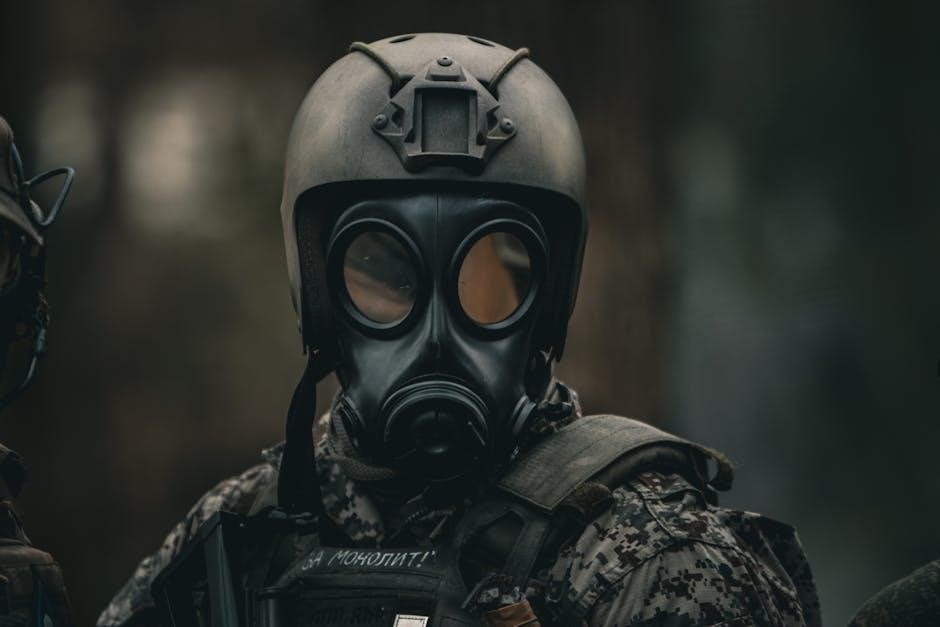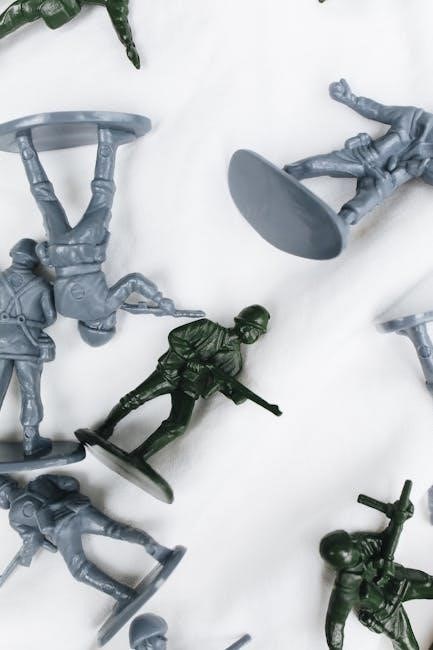World War I, known as the Great War, lasted from 1914 to 1918. It was a global conflict involving major powers, causing massive destruction and societal changes.
Causes of World War I
The war resulted from militarism, alliances, imperialism, and nationalism, creating tensions among European powers that escalated after the assassination of Archduke Franz Ferdinand.
2.1 The Four Main Causes
The four main causes of World War I were militarism, alliances, imperialism, and nationalism. Militarism refers to the buildup of military forces and weapons, creating tension among nations. Alliances, such as the Triple Entente and Triple Alliance, divided Europe into opposing camps, escalating conflicts. Imperialism fueled competition for colonies and resources, while nationalism intensified ethnic and political tensions. These factors created a volatile environment that led to the assassination of Archduke Franz Ferdinand, triggering the war. The complex interplay of these causes ensured that a small dispute could spiral into a global conflict, drawing in more nations and resulting in unprecedented devastation.

Major Alliances of World War I
World War I was characterized by two major alliances: the Triple Entente and the Central Powers. The Triple Entente included France, Britain, and Russia, while the Central Powers consisted of Germany, Austria-Hungary, and Italy. These alliances were formed to maintain a balance of power in Europe and provide mutual defense in case of conflict. The complex system of alliances created a situation where a small dispute could quickly escalate into a larger war. Additionally, countries like the Ottoman Empire and Bulgaria later joined the Central Powers, further dividing Europe. These alliances played a crucial role in the outbreak and expansion of the war, as nations were drawn into the conflict to support their allies.

Key Events of World War I
Key events included the assassination of Archduke Franz Ferdinand, the introduction of tanks and poison gas, major battles like Verdun and Somme, and the U.S. entry in 1917.
4.1 Battle of the Marne
The Battle of the Marne, fought from September 5 to 12, 1914, was a pivotal event in World War I. It halted the German advance on Paris and forced their retreat, marking a significant Allied victory. The battle showcased the importance of strategic maneuvering and adaptability, as French and British forces effectively countered German tactics. The use of taxis to transport French troops to the front lines became a symbol of the battle’s urgency and ingenuity. The Marne’s outcome prevented a quick German victory and led to the prolonged trench warfare characteristic of the Western Front. Its significance lies in shifting the war’s momentum and demonstrating the resilience of Allied forces.

Technological Advancements in World War I
World War I introduced groundbreaking technologies, transforming warfare. Machine guns, artillery, tanks, and aerial combat debuted, while trench systems and chemical weapons reflected the industrialization of conflict.
5.1 Tanks
Tanks were a groundbreaking innovation in World War I, first introduced by the British in 1916 during the Battle of the Somme. Designed to break through enemy trenches and withstand machine gun fire, tanks revolutionized land warfare. The first operational tank, named “Little Willie,” was developed to navigate barbed wire and traverse trenches, offering a new dimension to battlefield tactics. Early models were slow and mechanically unreliable but marked the beginning of armored warfare. By 1918, tanks had become a symbol of modern warfare, influencing future military strategies. Their introduction signified the shift toward mechanized combat, transforming how armies engaged on the battlefield.
5.2 Aerial Warfare
Aerial warfare emerged as a new dimension in World War I, transforming military tactics and strategies. Initially used for reconnaissance, aircraft soon evolved into weapons of war. Fighter planes, equipped with machine guns, engaged in dogfights, while bombers targeted enemy positions. The Red Baron, Manfred von Richthofen, became a legendary figure, symbolizing the era’s aerial combat. By 1918, air forces had grown significantly, influencing ground battles and strategic decisions. Aerial warfare marked the beginning of a new era in military technology, laying the groundwork for the dominance of air power in future conflicts; Its introduction highlighted the rapid adaptation of nations to technological advancements during the Great War.
5.3 Chemical Weapons
Chemical weapons were first introduced in World War I, marking a devastating escalation in warfare. Germany initiated their use in 1915, deploying chlorine gas at Ypres, causing widespread casualties. Mustard gas and phosgene soon followed, leading to severe burns, respiratory damage, and long-term suffering. These weapons terrorized soldiers, as gas masks provided limited protection. Their use violated international norms, leading to global condemnation. Despite their brutality, chemical weapons did not decisively alter the war’s outcome. The horrors they inflicted prompted post-war bans, such as the Geneva Protocol of 1925, aiming to prevent their future use. Chemical warfare remains a grim reminder of the Great War’s brutality and its impact on military ethics.

The Role of the United States
The United States initially maintained neutrality in World War I, focusing on economic gains by supplying arms and materials to both sides. However, growing tensions with Germany, including unrestricted submarine warfare and the sinking of passenger ships like the Lusitania, shifted public opinion. In 1917, Germany’s resumption of submarine attacks and the revelation of the Zimmermann Telegram, which sought to ally with Mexico against the U.S., led Congress to declare war on Germany.
American forces, known as the American Expeditionary Forces, arrived in Europe in 1918, playing a crucial role in turning the tide of the war. The U.S. contributed financially through Liberty Bonds and introduced new military technologies, such as tanks and aerial warfare, enhancing Allied capabilities. The U.S. entry marked a significant shift in the global balance of power, solidifying its emergence as a major world power.
The Home Front During World War I
During World War I, the home front experienced significant changes as societies mobilized for total war. Economies shifted to war production, with governments controlling industries and resources. Propaganda campaigns were launched to maintain public support, while rationing and inflation became common challenges for civilians. Women entered the workforce in unprecedented numbers, replacing men who had enlisted in the military.
Governments also implemented measures to suppress dissent, such as censorship and conscription laws. Despite these efforts, war weariness and anti-war movements grew as casualties mounted and living conditions deteriorated. The home front became a critical theater of the war, shaping both the conflict’s outcome and post-war societies.
The Treaty of Versailles
The Treaty of Versailles, signed in 1919, officially ended World War I. It imposed harsh penalties on Germany, including heavy reparations and territorial losses, fueling German resentment.
8.1 Main Terms
The Treaty of Versailles included several key terms that shaped its outcome. The War Guilt Clause blamed Germany for the war, forcing it to accept responsibility. Reparations required Germany to pay massive damages to Allied nations, causing economic hardship. Territorial losses led to the redrawing of Europe’s map, with Germany losing significant land, including Alsace-Lorraine to France. Military restrictions limited Germany’s armed forces, prohibiting an airforce and restricting its navy and army. The treaty also established the League of Nations, an international organization aimed at preventing future conflicts. These terms deeply angered Germany, contributing to widespread resentment and setting the stage for future tensions.

Social and Economic Impact
World War I had profound social and economic consequences. Economically, the war drained resources, leading to inflation, labor shortages, and widespread poverty. Many nations, especially in Europe, faced economic instability. The United States emerged as a dominant economic power, while European industries were devastated. Socially, the war reshaped societies, with women entering the workforce in unprecedented numbers. Class divisions deepened, and political unrest grew. The war also led to the rise of revolutionary movements, such as Bolshevism in Russia. Economically, Germany suffered greatly under the Treaty of Versailles, facing hyperinflation and unemployment. These changes laid the groundwork for future global tensions and societal shifts, leaving a lasting legacy of economic hardship and social transformation.
The Christmas Truce of 1914
The Christmas Truce of 1914 was a rare moment of peace during World War I, occurring along the Western Front. Despite being enemies, Allied and German soldiers spontaneously ceased fighting, exchanged gifts, and even played soccer. This unofficial truce symbolized humanity amidst the brutality of war, showing mutual respect and camaraderie. The event highlighted the soldiers’ desire for peace and their ability to connect beyond nationality. However, it was not universally observed and was quickly suppressed by commanding officers. This unique incident remains a poignant reminder of the war’s human cost and the longing for peace, even in the midst of conflict.

Key Figures of World War I
Several individuals played pivotal roles during World War I, shaping its course and outcome. Political leaders like Woodrow Wilson of the United States and David Lloyd George of Britain influenced global diplomacy. Military commanders such as General Ferdinand Foch and Field Marshal Douglas Haig led Allied forces, while Kaiser Wilhelm II and General Erich Ludendorff represented Germany’s leadership. Key figures also included Tsar Nicholas II of Russia and Emperor Franz Joseph of Austria-Hungary, whose decisions impacted the war’s escalation. Additionally, notable individuals like Herbert Kitchener and Georges Clemenceau played crucial roles in mobilizing resources and strategies. These leaders’ actions and decisions significantly influenced the war’s progression and its lasting effects on the world.
Major Battles and Their Significance
World War I featured numerous pivotal battles that shaped its outcome. The Battle of Tannenberg (1914) showcased Germany’s strategic brilliance, while the Battle of Gallipoli (1915-1916) highlighted Allied failures. The Battle of Verdun (1916) and the Battle of the Somme (1916) exemplified the horrors of trench warfare, with massive casualties and little territorial gain. The Battle of Passchendaele (1917) became infamous for its devastating conditions, and the Battle of Cambrai (1917) introduced tanks to modern warfare. These battles demonstrated the futility of static warfare and the need for innovative strategies, ultimately influencing the war’s conclusion and its profound impact on global history.
World War I, known as the Great War, was a pivotal event in modern history, reshaping global politics, economies, and societies. It resulted in unprecedented human suffering, with millions of casualties and widespread destruction. The war marked the end of empires and the rise of new world powers, while also laying the groundwork for future conflicts, including World War II. The Treaty of Versailles imposed harsh penalties on Germany, fostering resentment that later contributed to Nazi aggression. Technological advancements and societal changes emerged from the war, influencing the 20th century profoundly. Understanding World War I is crucial for grasping its lasting impact on international relations and the importance of diplomacy in preventing such tragedies.